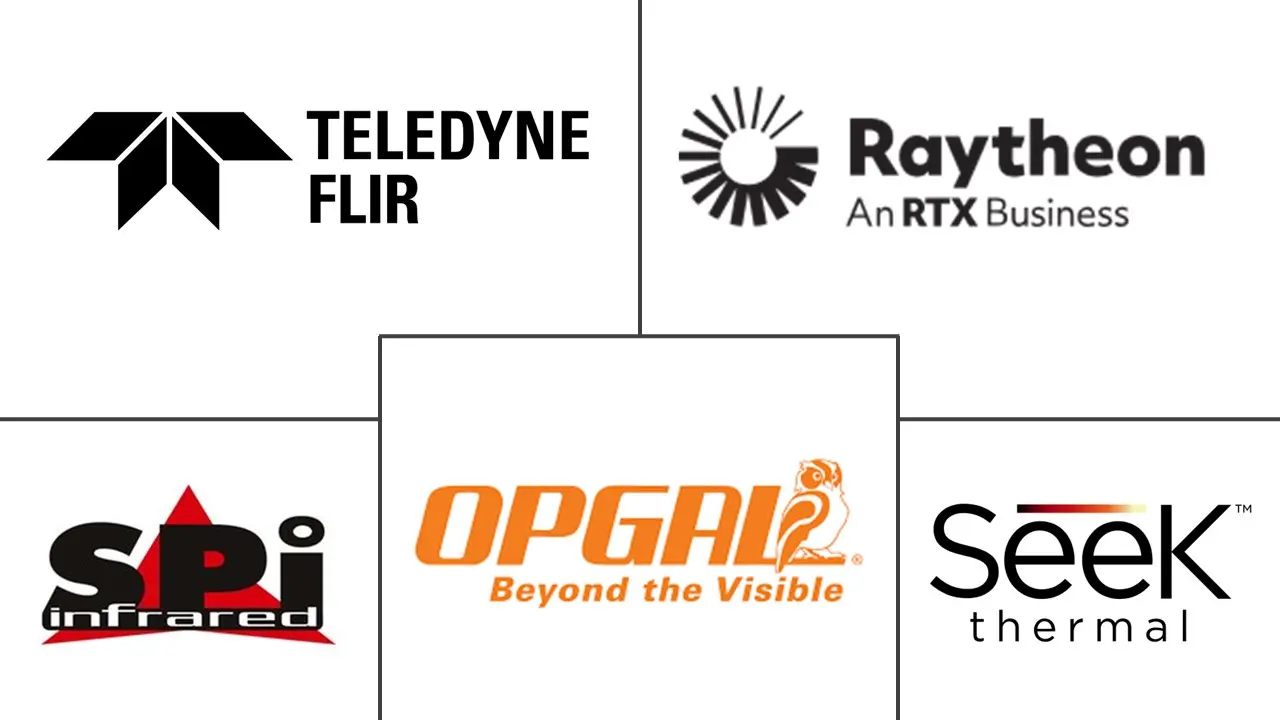IR (Infrared) Camera Market Size and Share
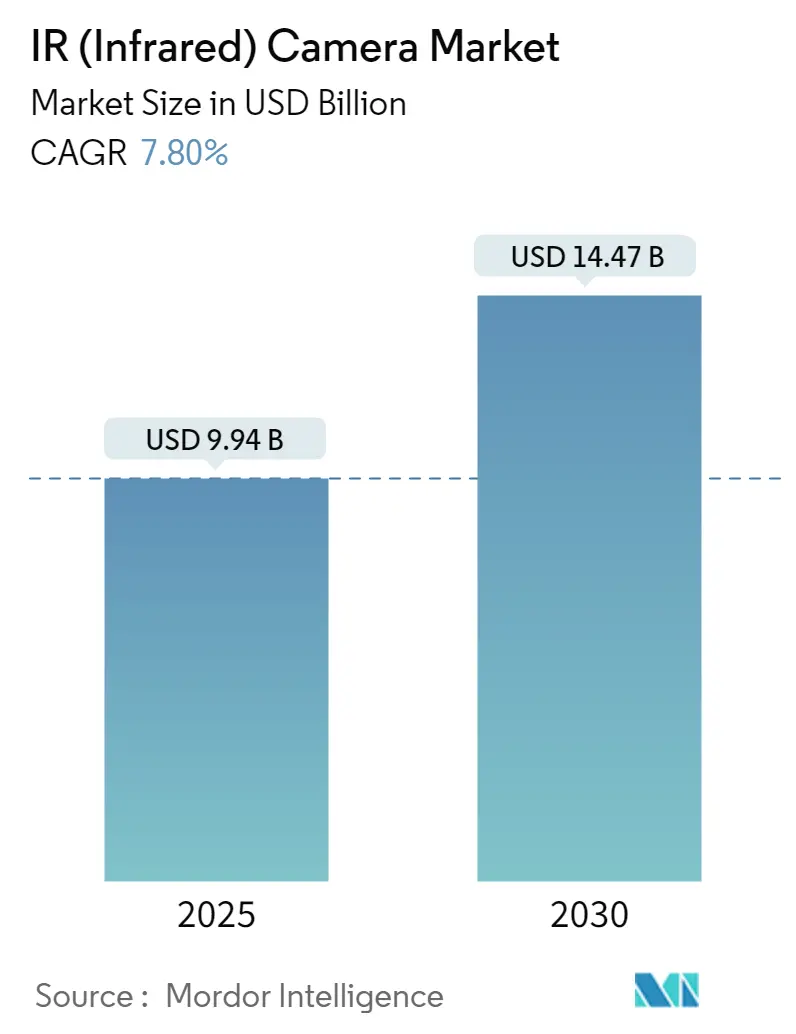
IR (Infrared) Camera Market Analysis by Mordor Intelligence
The IR Camera Market size is estimated at USD 9.94 billion in 2025, and is expected to reach USD 14.47 billion by 2030, at a CAGR of 7.8% during the forecast period (2025-2030).
The infrared camera industry is experiencing significant transformation driven by technological convergence and increasing defense expenditure globally. Major economies are substantially increasing their defense budgets, with China announcing a 7.2% increase to CNY 1.55 trillion in 2023 and Japan allocating JPY 7.95 trillion for the fiscal year 2024. These investments are facilitating the development of advanced surveillance systems and military applications incorporating IR camera market technology. The integration of artificial intelligence and machine learning with IR cameras is enabling enhanced threat detection capabilities and improved image processing, leading to more sophisticated and efficient surveillance systems.
The automotive sector is emerging as a crucial growth catalyst for the IR camera market, particularly in the context of autonomous vehicles and advanced driver assistance systems (ADAS). According to Intel's projections, global car sales are expected to reach 101.4 million units by 2030, with autonomous vehicles accounting for approximately 12% of car registrations. Major automotive manufacturers are increasingly incorporating IR cameras for night vision systems, driver monitoring, and enhanced safety features. This trend is particularly evident in India, where the automotive sector is growing at a steady annual rate of 9.5% according to IBEF.
Recent strategic partnerships and technological innovations are reshaping the competitive landscape. In January 2024, Valeo and Teledyne FLIR announced a strategic collaboration to introduce thermal imaging technology for automotive safety applications, securing a significant contract from a global automotive OEM. Similarly, in February 2024, UK-based Norden Communication partnered with India's Centre for Development of Advanced Computing (C-DAC) to develop AI-powered thermal cameras for security and industrial applications, demonstrating the industry's move toward more sophisticated solutions.
The market is witnessing a significant shift toward integrated solutions that combine multiple technologies. In February 2024, South Korea launched a development program for UAVs equipped with high-performance Electro-Optical/Infrared (EO/IR) cameras and multi-function radars for maritime surveillance. Additionally, Hanwha Vision introduced AI-based radiometric thermal cameras in January 2024, featuring precise temperature measurements and enhanced security capabilities, illustrating the growing trend toward multi-functional IR camera systems that can serve various applications simultaneously.
Global IR (Infrared) Camera Market Trends and Insights
Rising Demand for Surveillance Across Various Verticals
Surveillance technologies have become integral to various end-user verticals, offering enhanced security measures and improved operational efficiency across multiple industries. From retail and healthcare to transportation and education, the demand for surveillance systems continues to rise, transforming how organizations function and operate. The integration of IR cameras with advanced video analytics enables real-time monitoring and detection of potential threats, while their ability to function effectively in low-light conditions makes them invaluable for 24/7 surveillance operations.
In the manufacturing and logistics sectors, surveillance systems have become essential tools for ensuring efficient operations and minimizing risks. Surveillance technologies, such as CCTV cameras and IoT-enabled sensors, enable real-time monitoring of production lines, warehouses, and transportation routes. This enhances productivity, prevents theft and pilferage, and ensures compliance with safety regulations. The application of IR cameras in border control for security surveillance is another major driving factor, as these cameras help reduce danger for employees, soldiers, and civilians working or living in border areas while helping security personnel overcome geographical challenges like mountains, snow, forests, deserts, harsh weather, and water bodies.
Gradually Decreasing Costs of Thermal Cameras
Thermal cameras have traditionally been associated with expensive and specialized applications, such as military and industrial use. However, in recent years, the cost of thermal cameras has been steadily decreasing, making them more accessible to a wider range of industries and consumers. One of the primary reasons for the decreasing cost is the rapid advancement of technology. Innovations in sensor technology, image processing algorithms, and miniaturization have led to the production of smaller, more efficient, and cost-effective thermal cameras. As manufacturing processes become more streamlined, economies of scale are realized, resulting in reduced production costs.
The integration of thermal cameras with other technologies, such as artificial intelligence and machine learning, has further contributed to the decreasing cost while increasing their value proposition. By leveraging AI algorithms, thermal cameras can now provide more accurate and actionable insights. Additionally, improvements in manufacturing processes and production scalability have played a crucial role in reducing costs. As manufacturers optimize their production lines and increase production volumes, the cost per unit decreases. Advancements in materials and components have also contributed to cost reductions, making thermal cameras more affordable for both businesses and consumers.
Segment Analysis: By Detector
Uncooled Segment in IR Camera Market
The uncooled segment dominates the IR camera market, commanding approximately 74% market share in 2024. This significant market position can be attributed to the segment's cost-effectiveness and technological advantages. Uncooled infrared cameras do not require cryogenic cooling as their detector design is based on microbolometer technology, which consists of tiny resistors on silicon elements with large surface areas, low heat capacity, and excellent thermal isolation. These cameras are particularly effective in the longwave infrared band (7μ-14μ), offering superior penetration in challenging environmental conditions like dust, fog, and smoke. The segment's dominance is further reinforced by the gradual decrease in production costs of uncooled thermal camera systems, with sensors ranging between USD 200-10,000, making them significantly more affordable than their cooled counterparts. Additionally, uncooled cameras require minimal maintenance and can operate continuously for years, unlike cooled systems that need regular servicing.
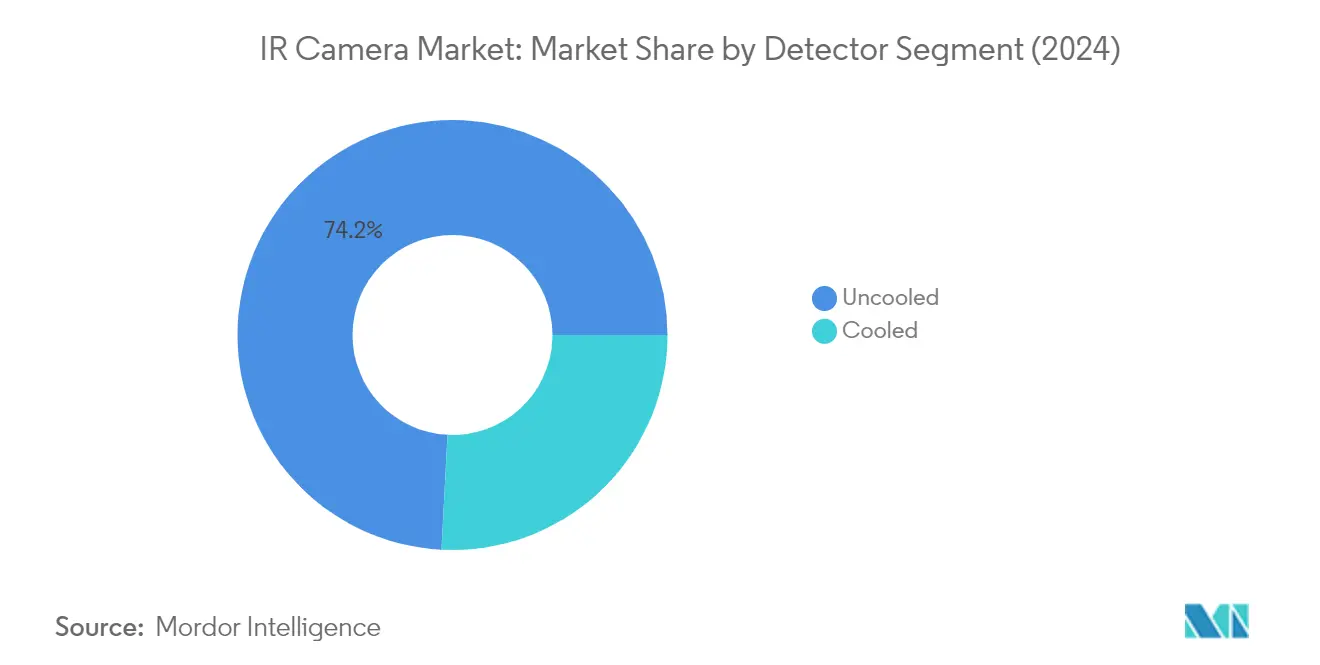
Cooled Segment in IR Camera Market
The cooled segment is projected to experience the highest growth rate in the IR camera market, with an expected CAGR of approximately 10% during the forecast period 2024-2029. This accelerated growth is driven by the segment's superior performance characteristics, particularly in applications requiring maximum accuracy and long-range detection. Cooled detectors offer enhanced sensitivity for high-speed MWIR applications and are particularly valuable in R&D and safety markets, especially for analyzing swift temperature changes in fast-moving objects. These cameras excel in detecting minute temperature differences over extended periods, providing superior detail and enabling the identification of even the faintest thermal anomalies. The segment's growth is further supported by recent developments in cooled infrared detector technology, leading to rapid advancement in various environmental applications, including hyperspectral remote sensing, space imaging, and surveillance, with some detectors capable of imaging in spectral bands with wavelengths up to 25 µm.
Segment Analysis: By Material
Germanium Segment in IR Camera Market
Germanium has established itself as the dominant material in the infrared camera market, being one of the most standard infrared materials utilized extensively in thermal camera lenses. Its versatility in operating across both MWIR and LWIR bands makes it particularly valuable. The material's high refractive index of approximately 4.0 through the 2-14μm band and substantial Knoop hardness of 780 make it ideal for producing various optical components in IR systems. Germanium's capabilities in non-destructive testing, combined with its excellent performance in thermal imaging and hot-spot detection applications, particularly in night vision systems and firefighting, have solidified its market position. The material's ability to be readily cut and polished into specialty camera lenses, coupled with its suitability as a substrate for diamond-like coatings, has made it the preferred choice for high-efficiency infrared imaging systems.
Silicon Segment in IR Camera Market
Silicon is emerging as the fastest-growing material segment in the infrared camera market, driven by significant technological advancements and cost advantages. The material's integration with wafer-level optics, wafer-level packaging, and innovative manufacturing processes is revolutionizing IR camera production. Silicon's high thermal conductivity and low weight characteristics make it particularly attractive for IR systems, especially in the 2-7μm range. The material's compatibility with MEMS technology and integrated circuit process sequences has opened new possibilities for miniaturizing sensors and actuators. The growing adoption of silicon-based sensors in machine vision applications, coupled with their greater speed, quantum efficiency, and lower read noise compared to CCD technology, is driving rapid market expansion.
Remaining Segments in IR Camera Materials Market
The remaining segments in the IR camera materials market include Sapphire and other materials like Zinc Selenide (ZnSe), Chalcogenide (ChG), and Calcium Fluoride (CaF2). Sapphire has carved out a significant niche in specialized applications requiring high optical clarity and broad light transmission spectrum, particularly in harsh environmental conditions. Its exceptional compressive strength, chemical resistance, and thermal stability make it invaluable for specific industrial applications. Other materials like Chalcogenide glass are gaining prominence through precision glass molding techniques, offering cost-effective alternatives for serial production quantities, while materials such as Zinc Selenide and Calcium Fluoride serve specific wavelength requirements in thermal imaging and spectral applications.
Segment Analysis: By Type
Long-wavelength IR Segment in IR Camera Market
The Long-wavelength IR (LWIR) segment dominates the global infrared camera market, commanding approximately 65% of the market share in 2024. LWIR cameras have established themselves as the primary devices for temperature testing and measurement applications across various industries. These cameras excel in accurately measuring surface temperature profiles of objects, enabling the detection of heat radiation even at considerable distances or in complete darkness. Their effectiveness in outdoor applications stems from their lower sensitivity to ambient thermal noise, making them particularly valuable for building inspection, personal night vision camera, solar field scans, farm and produce analysis, thermal imaging surveillance, and search and rescue equipment for firefighters. The segment's dominance is further reinforced by LWIR cameras' ability to detect photons emitted directly by objects rather than capturing reflected light, making them especially effective for measuring skin surface temperature variations at a distance.
Near and Short-wavelength IR Segment in IR Camera Market
The Near and Short-wavelength IR (SWIR) segment is emerging as the fastest-growing segment in the infrared camera market, projected to grow at approximately 9% CAGR from 2024 to 2029. This remarkable growth is driven by several key advantages that SWIR technology offers compared to visible light when used for inspection, sorting, surveillance, quality control, and various other applications. SWIR cameras demonstrate superior capabilities in penetrating fog, clouds, and hazy air pollution while producing clear images that closely resemble regular black-and-white photographs. The technology's ability to see through many plastics that are opaque in visible light, while detecting strong absorption bands in common products like detergents, makes it invaluable for quality control applications. In agriculture and food inspection, SWIR cameras excel at detecting defects in vegetables and fruits, while in the security sector, they aid in counterfeit detection and art authentication. The segment's growth is further propelled by continuous innovations in sensor technology and increasing adoption across diverse industries.
Remaining Segments in IR Camera Market by Type
The Medium-wavelength IR (MWIR) segment represents a crucial component of the IR camera market, offering a balanced solution between long and short-wavelength capabilities. MWIR cameras operate in the 3-5 micrometer range and are highly effective across various environmental conditions, including fog, smoke, and dust. These cameras demonstrate exceptional thermal sensitivity, enabling them to detect minute temperature differences with high accuracy, making them particularly valuable for surveillance, security, and search and rescue operations. The technology's ability to capture detailed images with high spatial resolution has made it indispensable in industrial inspections and scientific research, where the visualization of fine details is crucial. The integration of advanced image processing algorithms and artificial intelligence capabilities has further enhanced the segment's value proposition, enabling automated analysis and anomaly detection across various applications.
Segment Analysis: By End-User Vertical
Commercial & Public Segment in IR Camera Market
The Commercial & Public segment dominates the infrared surveillance market, commanding approximately 43% market share in 2024. This segment's prominence is driven by the increasing adoption of video surveillance systems across banking institutions, retail establishments, and public infrastructure facilities. The deployment of thermal security camera systems in these sectors serves multiple purposes, including enhanced security monitoring, theft prevention, and operational efficiency improvement. Financial institutions are particularly investing in advanced surveillance systems to combat ATM thefts and suspicious transactions, while retail establishments utilize these cameras for loss prevention and customer behavior analysis. Additionally, public infrastructure sectors such as airports, railways, and stadiums are incorporating IR cameras with night vision capabilities for comprehensive monitoring of low-lit areas and critical installations.
Automotive Segment in IR Camera Market
The Automotive segment is experiencing remarkable growth, projected to expand at approximately 11% during the forecast period 2024-2029. This accelerated growth is primarily driven by the increasing integration of IR cameras in advanced driver assistance systems (ADAS) and autonomous vehicles. These cameras enhance thermal vision capabilities, enabling improved detection of pedestrians, animals, and obstacles in low-light conditions. The automotive industry's focus on developing sophisticated safety features and the growing trend toward vehicle autonomy are further propelling the demand for IR cameras. Recent developments in thermal imaging technology specifically designed for automotive applications, coupled with supportive government regulations mandating advanced safety features in vehicles, are creating substantial opportunities for market expansion in this segment.
Remaining Segments in End-User Vertical Market
The IR camera market encompasses several other significant segments including Military and Defense, Industrial, Residential, and Other End-user verticals. The Military and Defense sector utilizes IR cameras for surveillance, reconnaissance, and target acquisition applications, benefiting from continuous technological advancements in thermal imaging. The Industrial segment employs these cameras for predictive maintenance, equipment monitoring, and quality control processes across manufacturing facilities. The Residential segment is witnessing increased adoption of IR cameras for home security systems and smart home applications. Other end-user verticals, including healthcare, firefighting, and rescue operations, are also contributing to market growth through diverse applications such as medical imaging, fire detection, and search and rescue operations.
IR Camera Market Geography Segment Analysis
IR Camera Market in North America
North America represents a significant IR camera market, driven by substantial military spending, advanced technological infrastructure, and widespread adoption across various sectors. The United States and Canada form the key markets in this region, with applications spanning military and defense, automotive, industrial, and commercial sectors. The region's growth is supported by continuous technological innovations, increasing security concerns, and rising demand for surveillance systems across different verticals.
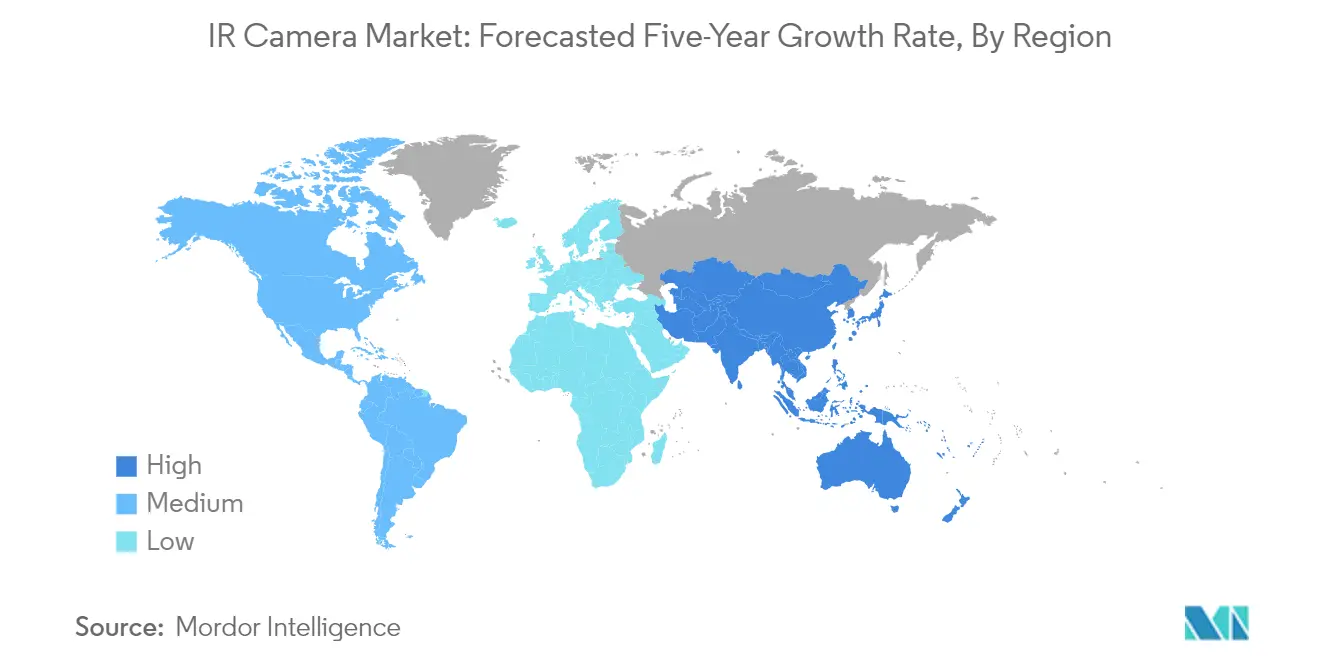
IR Camera Market in the United States
The United States dominates the North American IR camera market, holding approximately 89% of the regional market share in 2024. The country's market is primarily driven by its substantial military expenditure and robust defense sector. The implementation of advanced driver assistance systems (ADAS), rising demand for surveillance across various verticals, and increasing adoption in industrial applications further fuel market growth. The US market particularly benefits from the presence of major infrared camera manufacturers and continuous technological innovations in thermal imaging technology.
IR Camera Market in Canada
Canada emerges as the fastest-growing market in North America, with a projected CAGR of approximately 9% during 2024-2029. The country's market is experiencing rapid growth due to increasing investments in surveillance and security systems, particularly in household security, intelligent buildings, and outdoor security applications. The government's focus on enhancing border security and surveillance capabilities, coupled with rising industrial applications, continues to drive market expansion. Canadian companies are actively engaging in strategic partnerships and innovations to capitalize on these growing opportunities, contributing to the expansion of the thermal camera market.
IR Camera Market in Europe
The European IR camera market demonstrates strong growth potential, supported by increasing industrial automation, rising security concerns, and growing adoption in automotive applications. The region's market is characterized by the presence of several key countries, including Germany, France, and the United Kingdom, each contributing significantly to the market's development. The region benefits from strong research and development activities and the presence of major thermal camera manufacturers and related technologies.
IR Camera Market in Germany
Germany leads the European IR camera market, commanding approximately 28% of the regional market share in 2024. The country's dominant position is attributed to its strong industrial base, particularly in automotive manufacturing and industrial automation. German manufacturers are at the forefront of developing advanced infrared camera technologies, with several domestic players actively contributing to market growth through continuous innovation and product development.
IR Camera Market in France
France emerges as the fastest-growing market in Europe, with a projected CAGR of approximately 8% during 2024-2029. The country's market growth is driven by increasing defense spending and rising adoption of IR cameras in various sectors, including automotive, industrial, and security applications. French companies are actively engaged in research and development activities, particularly in developing advanced thermal imaging solutions for military and commercial applications.
IR Camera Market in Asia-Pacific
The Asia-Pacific region represents a dynamic market for IR cameras, characterized by rapid industrialization, increasing defense spending, and growing adoption of advanced surveillance systems. Key countries in this region include China, India, and Japan, each contributing significantly to market growth. The region's market is driven by expanding manufacturing capabilities, rising security concerns, and increasing investments in infrastructure development, contributing to the overall thermal camera market size.
IR Camera Market in China
China stands as the largest market for IR cameras in the Asia-Pacific region. The country's market dominance is supported by its extensive manufacturing capabilities, significant investments in defense and surveillance systems, and growing adoption across various industrial sectors. Chinese manufacturers have made significant strides in developing domestic infrared imaging technology, reducing dependency on imports and strengthening their market position.
IR Camera Market in China
China also emerges as the fastest-growing market in the Asia-Pacific region. The country's rapid growth is driven by increasing investments in smart city projects, rising adoption in automotive applications, and expanding industrial automation. The government's focus on enhancing domestic technological capabilities and supporting local manufacturers continues to drive market expansion.
IR Camera Market in the Rest of the World
The Rest of the World market, encompassing regions like Latin America and the Middle East & Africa, shows promising growth potential in the IR camera market. These regions are witnessing increasing adoption of IR cameras across various applications, particularly in oil and gas facilities, border security, and industrial monitoring. The market growth is supported by rising investments in infrastructure development, increasing security concerns, and growing industrial applications. The adoption of infrared cameras in customs and border control applications, particularly in the Middle East, demonstrates the expanding use cases for this technology.
Competitive Landscape
Top Companies in IR Camera Market
The IR camera market is characterized by intense, innovation-driven competition, with companies focusing on developing advanced thermal imaging solutions across multiple applications. Major players are investing heavily in research and development to enhance their product portfolios, particularly in areas like autonomous vehicles, military applications, and industrial automation. Companies are demonstrating operational agility through strategic partnerships and collaborations, especially in integrating IR technology with emerging platforms like drones and IoT devices. The industry has witnessed significant expansion through geographical diversification, with established players extending their presence across developing markets while simultaneously strengthening their position in traditional strongholds. Product customization capabilities, technological advancement in sensor development, and the ability to provide comprehensive solutions rather than standalone products have emerged as key differentiators in the competitive landscape.
Global Leaders Dominate Specialized Market Segments
The IR camera market exhibits a relatively concentrated structure, dominated by established global players with extensive technological capabilities and robust distribution networks. Companies like Teledyne FLIR, Raytheon, and Leonardo DRS have maintained their market leadership through their comprehensive product portfolios and strong presence in defense and industrial applications. These major players operate alongside specialized regional manufacturers who focus on specific market niches or geographical territories. The market has witnessed strategic consolidation through mergers and acquisitions, particularly aimed at acquiring technological capabilities or expanding into new geographical markets.
The competitive dynamics are shaped by the presence of both pure-play IR camera manufacturers and diversified technology conglomerates that offer IR cameras as part of their broader product portfolio. While pure-play manufacturers like FLIR Systems (now part of Teledyne) focus exclusively on thermal imaging solutions, conglomerates like Hikvision integrate IR technology into their wider security and surveillance offerings. The market has seen increased participation from Asian manufacturers, particularly Chinese companies, who are rapidly expanding their technological capabilities and global market presence through aggressive pricing strategies and continuous innovation.
Innovation and Integration Drive Market Success
Success in the IR camera market increasingly depends on companies' ability to integrate their solutions with emerging technologies and adapt to evolving customer requirements. Incumbent players are focusing on developing proprietary technologies, expanding their application-specific solutions, and strengthening their service and support infrastructure to maintain their market position. The ability to offer end-to-end solutions, including software integration and data analytics capabilities, has become crucial for market success. Companies are also investing in building strong relationships with key industry verticals like automotive, aerospace, and healthcare to ensure sustained demand and product development alignment.
For new entrants and challenger brands, success lies in identifying and exploiting underserved market segments while developing innovative business models that overcome entry barriers. The market shows moderate substitution risk, primarily from alternative sensing technologies, but the unique capabilities of IR cameras in thermal imaging applications provide significant protection against substitution. Regulatory compliance, particularly in defense and security applications, remains a critical success factor, with companies needing to navigate complex export control regulations and industry standards. The increasing focus on environmental monitoring and energy efficiency applications presents new opportunities for market players to diversify their revenue streams and reduce dependence on traditional market segments.
IR (Infrared) Camera Industry Leaders
-
Teledyne FLIR LLC (Teledyne Technologies)
-
SPI Corp.
-
OPGAL Optronic Industries Ltd (Elbit Systems)
-
Raytheon Company
-
Seek Thermal, Inc.
- *Disclaimer: Major Players sorted in no particular order
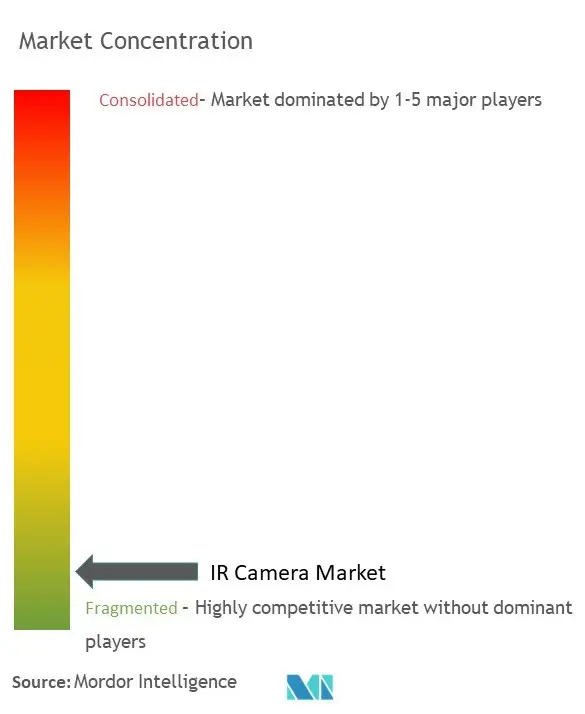
Recent Industry Developments
- February 2024 - Prama India's collaboration with the government of India's Centre for Development of Advanced Computing (C-DCAC) aims to support local production and innovation. The collaboration is being carried out through a Transfer of technology (TOT) agreement and will focus on thermal camera manufacturing, marketing, and support. Prama India's collaboration with C-DCAC is a step forward in R&D activities using technology to develop next-generation thermal cameras.
- January 2024 - Teledyne FLIR, a subsidiary of Teledyne Technologies Incorporated, has recently launched an upgraded version of its K-Series thermal imaging cameras (TICs), specifically designed for firefighting and search and rescue (SAR) applications. These enhanced TICs offer improved image clarity and sharpness, particularly in low-contrast situations. This upgrade enhances operator safety and efficiency by providing a clearer overall perception. The advanced image processing in the upgraded K-Series brings notable improvements in image quality across the entire imaging spectrum.
Global IR (Infrared) Camera Market Report Scope
The IR camera market is defined by the revenue generated from selling infrared cameras offered by different market players for a diverse range of end-user industries. The market trends are evaluated by analyzing the investments made in product innovation, diversification, and expansion. Further, the advancements in military & defense, automotive, and manufacturing sectors are also crucial in determining the market growth.
The IR camera market is segmented by the detector (cooled, uncooled), by material (germanium, silicon, sapphire, other materials), by type (near and short-wavelength IR, medium-wavelength IR, long-wavelength IR), by end-user vertical (military and defense, automotive, industrial, commercial and public, residential, and other end-user vertical), and by geography (North America [United States, Canada], Europe [United Kingdom, Germany, France, Rest of Europe], Asia-Pacific [China, India, Japan, Rest of Asia-Pacific], Rest of the World). The report offers market forecasts and size in value (USD) for all the above segments.
| Cooled |
| Uncooled |
| Germanium |
| Silicon |
| Sapphire |
| Other Materials |
| Near and Short-wavelength IR |
| Medium-wavelength IR |
| Long-wavelength IR |
| Military and Defense |
| Automotive |
| Industrial |
| Commercial and Public |
| Residential |
| Other End-user Vertical |
| North America | United States |
| Canada | |
| Europe | United Kingdom |
| Germany | |
| France | |
| Asia | China |
| India | |
| Japan | |
| Australia and New Zealand | |
| Latin America | |
| Middle East and Africa |
| By Detector | Cooled | |
| Uncooled | ||
| By Material | Germanium | |
| Silicon | ||
| Sapphire | ||
| Other Materials | ||
| By Type | Near and Short-wavelength IR | |
| Medium-wavelength IR | ||
| Long-wavelength IR | ||
| By End-user Vertical | Military and Defense | |
| Automotive | ||
| Industrial | ||
| Commercial and Public | ||
| Residential | ||
| Other End-user Vertical | ||
| By Geography | North America | United States |
| Canada | ||
| Europe | United Kingdom | |
| Germany | ||
| France | ||
| Asia | China | |
| India | ||
| Japan | ||
| Australia and New Zealand | ||
| Latin America | ||
| Middle East and Africa | ||
Key Questions Answered in the Report
How big is the IR Camera Market?
The IR Camera Market size is expected to reach USD 9.94 billion in 2025 and grow at a CAGR of 7.80% to reach USD 14.47 billion by 2030.
What is the current IR Camera Market size?
In 2025, the IR Camera Market size is expected to reach USD 9.94 billion.
Who are the key players in IR Camera Market?
Teledyne FLIR LLC (Teledyne Technologies), SPI Corp., OPGAL Optronic Industries Ltd (Elbit Systems), Raytheon Company and Seek Thermal, Inc. are the major companies operating in the IR Camera Market.
Which is the fastest growing region in IR Camera Market?
Asia Pacific is estimated to grow at the highest CAGR over the forecast period (2025-2030).
Which region has the biggest share in IR Camera Market?
In 2025, the Asia Pacific accounts for the largest market share in IR Camera Market.
What years does this IR Camera Market cover, and what was the market size in 2024?
In 2024, the IR Camera Market size was estimated at USD 9.16 billion. The report covers the IR Camera Market historical market size for years: 2019, 2020, 2021, 2022, 2023 and 2024. The report also forecasts the IR Camera Market size for years: 2025, 2026, 2027, 2028, 2029 and 2030.
Page last updated on:
